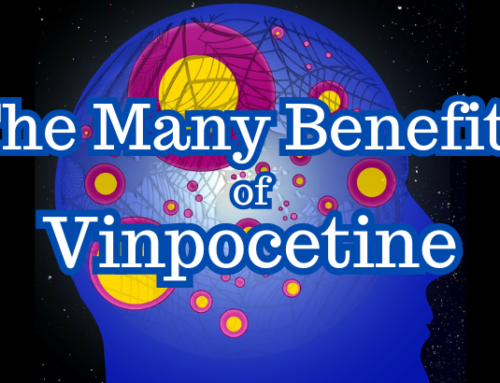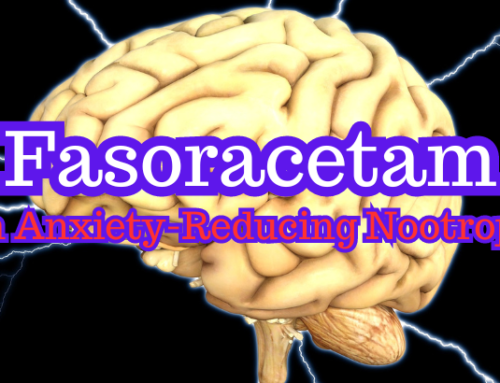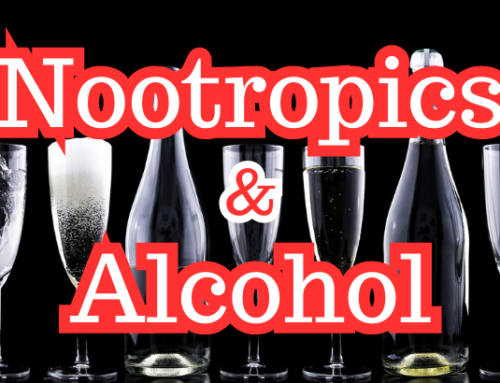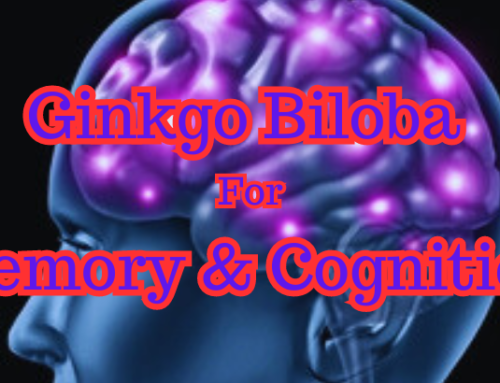Have you ever had one of those days where you're full of energy, get tons of stuff done, and you feel more focused than a laser beam? Do you wish there was a way to have those kinds of days more frequently?
Thanks to the wonderful world of nootropics, you can. That's exactly how I felt the the first time I tried adrafinil: I had more energy, was super productive, and felt focused all day long.
In this article, we're going to take a look at the nootropic adrafinil. It has a long history of use and plenty of science to support its effectiveness. But first, let's see what adrafinil is.
What is adrafinil?
This is a common nootropic that is sold as a dietary supplement. Adrafinil is popular in the nootropics community because it is easily available without a prescription and can increase focus, attention, alertness, wakefulness, and even improve mood.
French chemists discovered adrafinil in 1974. They studied this novel substance and found it to have eugeroic (wakefulness-promoting) and stimulant-like effects.1 After years of clinical trials and human studies by Cephalon Laboratories (originally Lafon), adrafinil was authorized for use in 1981.2
In France, adrafinil was a prescription drug from 1985 to 2011, sold under the trade name Olmifon.3 It was classified as a non-amphetamine psychostimulant, used to treat narcolepsy and disorders of vigilance, attention, and ideomotor slowdown in the elderly.2
In 2011, Cephalon Laboratories voluntarily took adrafinil off the market. Newer, more potent eugeroics like modafinil had become available. But just because adrafinil was no longer a prescription drug didn't mean it wasn't still in demand. By 2011, adrafinil had become popular nootropic – not just in France but around the world.
Nootropic benefits of adrafinil
Though adrafinil was approved in France to treat narcolepsy and age-related cognitive decline, they knew it could be beneficial for healthy people, too. It was often prescribed off-label (for uses other than what it's approved for) for fatigue, daytime tiredness, shift work, and as a general mind-and-mood booster.4
Adrafinil has been used around the world as a nootropic for decades. Here are just some of the nootropic benefits adrafinil users often report:
 Increased focus
Increased focus- Increased productivity
- Increased alertness/wakefulness
- Increased motivation
- Improved mood
With a list of potential benefits like that, it's not hard to see why adrafinil has remained popular in the nootropics community. But what does the science have to say? Let's take a look at some of the research that has been done on adrafinil to see if the data support these claims.
A 1990 study looked at the effect adrafinil had on 304 people between the ages of 45 and 88 who had difficulties with attention, concentration, and memory, and also showed signs of depression.5 Participants were given 900 milligrams (mg) a day of adrafinil in two divided doses (600 mg in the morning and another 300 mg at noon) for 3 months. The researchers found significant improvements in vigilance, attention, concentration, mood, and anxiety. They also noted that there were no serious adverse effects.
A double-blind, placebo-controlled study published a year earlier looked at the effect adrafinil had on hospitalized patients who presented with difficulty staying awake and vigilant.6 The researchers found that the participants who received adrafinil were less depressed, less irritable, more sociable, more patient, and showed overall cognitive improvement.
 Another placebo-controlled study looked at the effect adrafinil had on people between the ages of 45 and 79 who complained of memory, concentration, and attention problems.7 548 participants were split up into two groups. Participants in the group that received adrafinil showed significant improvements in attention, memory, orientation, and activities of daily living. The researchers did not mention any adverse effects.
Another placebo-controlled study looked at the effect adrafinil had on people between the ages of 45 and 79 who complained of memory, concentration, and attention problems.7 548 participants were split up into two groups. Participants in the group that received adrafinil showed significant improvements in attention, memory, orientation, and activities of daily living. The researchers did not mention any adverse effects.
Lastly, a 1987 study compared the effectiveness of adrafinil versus clomipramine (a tricyclic antidepressant) or placebo in the treatment of depression.8 Participants were given either 600 mg/day of adrafinil, 40 mg/day of clomipramine, or a placebo for two months. Those in both the adrafinil and clomipramine groups showed significant reductions in their depressive symptoms while the participants in the placebo group did not. The researchers also noted that while 50% of participants given clomipramine experienced side effects, adrafinil was well tolerated.
As you can see, there is plenty of research to support the claims made by adrafinil users. Studies consistently show that it can improve memory, mood, alertness, focus, and more. While no studies have been done on young, healthy volunteers specifically examining adrafinil's nootropic effects, it's reasonable to believe in the benefits users often report based on the research that's been done. And research has been done on similar substances like modafinil and armodafinil, showing them to have a variety of mood-and-cognition-boosting effects.9
How does adrafinil work?
Adrafinil is a prodrug of modafinil.4 In other words, when you take adrafinil, the body converts it into modafinil. For this reason, it often takes up to an hour for adrafinil's effects to be felt while the effects of modafinil are usually felt in half of that.
 While adrafinil's exact mechanisms of action are unknown (like all drugs that affect the brain), several studies have shed light on how it works. Originally, it was thought that adrafinil's effects were caused by its ability to agonize (bind to) alpha-adrenergic receptors.10 However, two additional mechanisms of action have been more recently proposed.
While adrafinil's exact mechanisms of action are unknown (like all drugs that affect the brain), several studies have shed light on how it works. Originally, it was thought that adrafinil's effects were caused by its ability to agonize (bind to) alpha-adrenergic receptors.10 However, two additional mechanisms of action have been more recently proposed.
The first is that adrafinil's effects are caused, at least in part, by its ability to affect certain neurotransmitters in the brain. These are chemical messengers that send signals throughout the nervous system.11 Research has shown that modafinil affects the release of both inhibitory and excitatory neurotransmitters. In particular, dopamine, gamma-aminobutyric acid (GABA), and glutamate.12
The other proposed mechanism of action states that adrafinil's effects are caused by its ability to increase cerebral (brain) metabolism. Researchers have found that modafinil increases levels of glutamine synthetase,13 aspartate, and inositol in parts of the brain.14 This indicates that it increases cerebral metabolism.
Additionally, several studies have shown modafinil to be neuroprotective. A study published in 1993 showed that modafinil may protect against certain kinds of mechanical brain injury.15 A 2012 study further showed that modafinil had a neuroprotective effect by reducing methamphetamine-induced neuroinflammation.16
Adrafinil safety & potential side effects
Adrafinil seems to be safe for short-term use in most people. However, there haven't been any human studies done to assess adrafinil's long-term safety. But studies have been done that show modafinil is safe for long-term (up to 10 years) use.17
Animal studies have shown that daily, high-dose adrafinil is non-toxic. Rats given up to 400 mg/kg of adrafinil for one month or up to 200 mg/kg for three months failed to show any signs of toxicity.4
![]() The potential side effects of adrafinil use are uncommon and (unsurprisingly) very similar to those of modafinil. Affecting less than 10% of people who use it, these potential side effects may include headache, nausea, reduced appetite, insomnia, upset stomach, anxiety, and dizziness.18
The potential side effects of adrafinil use are uncommon and (unsurprisingly) very similar to those of modafinil. Affecting less than 10% of people who use it, these potential side effects may include headache, nausea, reduced appetite, insomnia, upset stomach, anxiety, and dizziness.18
While side effects are uncommon and usually mild from both substances, they are more commonly found with adrafinil use. Since it has to be convert into modafinil, this puts additional strain on the body. Side effects more commonly experienced by adrafinil users include upset stomach, anxiety, and skin irritation. High-dose, long-term use of adrafinil (but not modafinil) may also elevate liver enzymes in some people.19
It's worth noting that modafinil's potential for addiction and dependence has been shown to be very low, especially compared to things like amphetamine and caffeine.20 It's reasonable to assume this holds true for adrafinil as well, if not more so.
That being said, people who have had problems with addiction to other substances should be cautious. Anything with the potential to change how you feel can be addictive for some people. However, research has shown that modafinil may increase abstinence rates in cocaine addicts21 and reduce drug-seeking behavior in methamphetamine-conditioned rats.22
Lastly, if you are a competitive athlete who is subject to drug testing, you should know that adrafinil is on the World Anti-Doping Agency's (WADA) prohibited-substances list.23 Adrafinil and modafinil were added to WADA's prohibited-substances list in 2004.
Adrafinil dosage
![]() A typical adrafinil dosage is anywhere from 600-1,200 mg.24 It is commonly taken in one dose but can be split up into two. Since taking adrafinil too late in the day can lead to insomnia, it's usually best to take it in only in the morning. However, if you're using it to help you stay up all night to study or for shift work, you may want to take it later in the day.
A typical adrafinil dosage is anywhere from 600-1,200 mg.24 It is commonly taken in one dose but can be split up into two. Since taking adrafinil too late in the day can lead to insomnia, it's usually best to take it in only in the morning. However, if you're using it to help you stay up all night to study or for shift work, you may want to take it later in the day.
Adrafinil works best when taken on an empty stomach. Taking adrafinil after eating will increase the time it takes to kick in and decrease its overall effects.
Where to buy adrafinil
When I first began researching nootropics nearly a decade ago, adrafinil was available from a number of different online vendors. But now that modafinil and armodafinil are widely available online, adrafinil is much harder to find.
 Most people prefer modafinil or armodafinil to adrafinil. They require a lower dosage, kick in faster, have less potential side effects, and are widely available. However, since modafinil is a prescription drug in many countries, in spite of it being easy to find online, some people would rather buy adrafinil.
Most people prefer modafinil or armodafinil to adrafinil. They require a lower dosage, kick in faster, have less potential side effects, and are widely available. However, since modafinil is a prescription drug in many countries, in spite of it being easy to find online, some people would rather buy adrafinil.
If you're one of those people, the best place to buy adrafinil online is from Science.bio. They offer adrafinil in both powder and liquid form. Science.bio has an awesome selection of high-quality products, fast shipping, reasonable prices, and great customer service.
Conclusion
There's no question about it: for most people, adrafinil can be a powerful nootropic. It's been used for decades and there is plenty of research to support adrafinil's safety and effectiveness.
However, adrafinil use has been steadily declining for years. With newer, more potent, faster-acting, and safer eugeroics like modafinil and armodafinil now widely available, nootropics users have been favoring these substances.
I've tried all three and find them all to have similar benefits and side effects. But I haven't taken adrafinil in years and likely never will again since the safer, stronger, faster-acting alternatives are easily available. For a more in-depth look at how these three eugeroics stack up against each other, check out this article: Modafinil, Adrafinil, & Armodafinil – Which Is Better?
Have you tried adrafinil? How does it compare to other nootropics you've tried? Please leave your answers in the comments section at the bottom of the page. And to learn about some newer eugeroics that have come on the market in recent years, you may want to read The Different Afinils.
To learn more about nootropics, sign up for the Nootropics Zone newsletter. You'll get the free gift, The Ultimate Nootropics Quick Reference Guide.
References
1Guglietta, A. (2015). Drug treatment of sleep disorders. Springer. ISBN: 978-3-319-11514-6
2ANSM. (2011, Feb. 12). Point d’information sur les dossiers discutés en commission d’AMM Séance du jeudi 1er décembre 2011 – Communiqué.
3Medpharm Scientific Publ. (2000). Index nominum 2000 international drug directory. Taylor & Francis. ISBN: 978-3-88763-075-1
4Milgram, N., Callahan, H., & Siwak, C. (1999). Adrafinil: a novel vigilance promoting agent. CNS Drug Reviews, 5(3):193-212.
5Kohler, F., & Lubin, S. (1990). Étude en médecine générale de l’intérêt thérapeutique d’Olmifon chez des malades présentant des symptomes précoces de vieillissement cérébral handicapant leur activité quotidienne. Étude ouverte pragmatique chez 304 patients. La Vie Médicale 2:335-44.
6Dewailly, P., Durocher, A., Durot, A., et al. (1989). Adrafinil et ralentissement du sujet âgé institutionnalisé: De la significativité statistique à la pertinence clinique (résultat d’une étude multicentrique en double aveugle versus placebo). Actual Med Int Psychiatry, 6:1–8.
7Boyer, P. (1994). Age et performance cognitives, plaintes mnesiques et attentionnelles au quotidien. Synapse spécial: Vers une medecine des comportements, 1–4.
8Guyotat, J. (1987). Intérèt de l’adrafiil dans le traitement des manifestations dépressives des malades âgés. Psychol Med, 1901–1910.
9Urban, A., & Cubala, W. (2020). The role of eugeroics in the treatment of affective disorders. Psychiatria Polska, 54(1):21-33.
10Duteil, J., Rambert, F., Pessonnier, J., et al. (1979). A possible alpha-adrenergic mechanism for drug (CRL 40028)-induced hyperactivity. European Journal of Pharmacology, 59(1-2):121-3.
11Neurotransmitter. (n.d.). Wikipedia.org. Retrieved July 23, 2021 from https://en.wikipedia.org/wiki/Neurotransmitter
12Ferraro, L., Tanganelli, S., O'Connor, W., et al. (1996). The vigilance promoting drug modafinil increases dopamine release in the rat nucleus acumbens via the involvement of a local GABAergic mechanism. European Journal of Pharmacology, 306(1-3):33-9.
13Touret, M., Sallanon-Moulin, M., Fages, C., et al. (1994). Effects of modafinil-induced wakefulness on glutamine synthetase regulation in the rat brain. Molecular Brain Research, 26(1-2):123-8.
14Pierard, C., Satabin, P., Lagarde, D., et al. (1995). Effects of a vigilance-enhancing drug, modafinil, on rat brain metabolism: a 2D COSY 1H-NMR study. Brain Research, 693(1-2):251-6.
15Ueki, A., Rosen, L., Andjber, B., et al. (1993). The vigilance-promoting drug modafinil counteracts the reduction of tyrosine hydroxylase immunoreactivity and of dopamine stores in nigrostriatal dopamine neurons in the male rat after a partial transection of the dopamine pathway. Experimental Brain Research, 93:259-70.
16Raineri, M., Gonzalez, B., Goitia, B., et al. (2012). Modafinil abrogates methamphetamine-induced neuroinflammation and apoptotic effects in the mouse striatum. PLOS One, 7(10):1-10.
17Ivanenko, A., Kek, L., & Grosrenaud, J. (2017). 0954 long-term use of modafinil and armodafinil in pediatric patients with narcolepsy. Sleep, 40(Suppl 1):A354-5.
18Greenblatt, K., & Adams, N. (2020). Modafinil. StatPearls.
19Schatzberg, A., & Nemeroff, C. (2009). The American Psychiatric Publishing Textbook of Psychopharmacology (4th ed.). American Psychiatric Publishing, Inc. ISBN: 978-1-58562-309-9
20Warot, D., Corruble, E., Payan, C., et al. (2020). Subjective effects of modafinil, a new central adrenergic stimulant in healthy volunteers: a comparison with amphetamine, caffeine, and placebo. European Psychiatry, 8(4):201-8.
21Sangroula, D., Motiwala, F., Wagle, B., et al. (2017). Modafinil treatment of cocaine dependence: a systematic review and meta-analysis. Substance Use & Misuse, 52(10):1292-306.
22Reichel, C., & See, R. (2011). Chronic modafinil effects on drug-seeking following methamphetamine self-administration in rats. International Journal of Neuropsychopharmacology, 15(7):919-29.
23World Anti-Doping Agency (WADA). (2007). The 2007 Prohibited List International Report. Retrieved July 23, 2021 from https://web.archive.org/web/20090410171528/http://www.wada-ama.org/rtecontent/document/2007_List_En.pdf
24Adrafinil. (2019, Sep. 17). Examine.com. Retrieved July 23, 2021 from https://examine.com/supplements/adrafinil/
[This article was originally published on June 26, 2015. Updated July 23, 2021.]







What is best for ADD
adrafinil or modafinil ?
Neither adrafinil nor modafinil have been FDA approved for the treatment of ADD/ADHD. That being said, many people find that they both help to improve attention and focus. Their effects are basically identical. Adrafinil converts into modafinil in the body. So modafinil kicks in a little faster and requires a lower dose. Otherwise, you’re likely to experience the same effect (or lack thereof) from both.